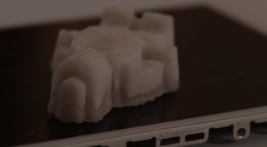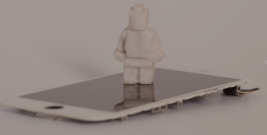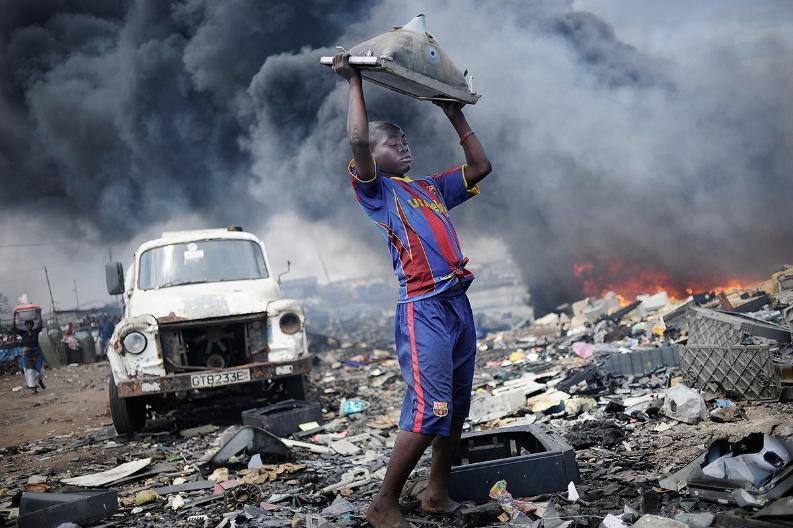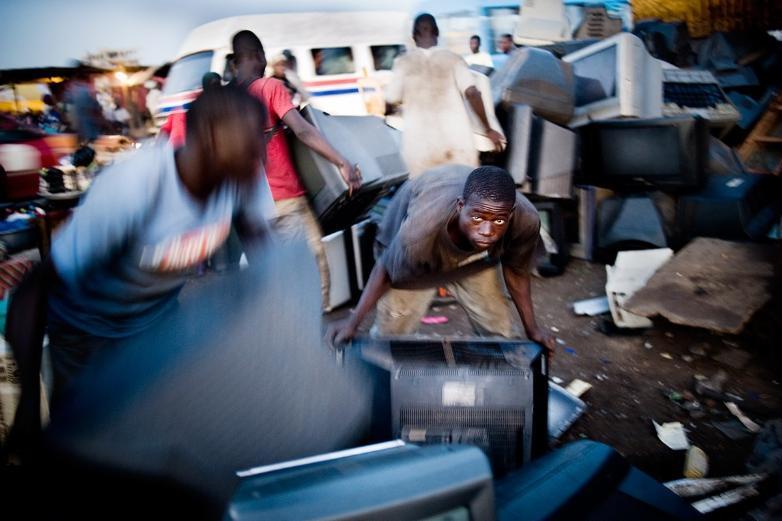
Invitation to the
e-waste FUNERAL
EACH YEAR THE PLANET generates some 50 million tons of electronic waste, ranging from mobile phones to toasters. Currently Africa is responsible for about 1.9 million tons of this e-waste total per year, but our continent is the most rapidly growing contributor.
With changing policies governing e-waste imports in China and India, Africa may become the next major dumping ground for the world’s toxic e-waste. Recently, China created new policies regulating the entry of e-waste into the country. The scouting for new dumping grounds has led prospectors to African countries in their search for areas with unregulated e-waste dumping potential. Only Cameroon and Nigeria have enforced national e-waste related legislation, while Ghana, Ethiopia and Kenya have legislation pending approval.
Considering the future of Africa in the e-waste crisis, the Sustainability Commons at the Environmental Learning Research Centre (ELRC) at Rhodes University is inviting students and staff to participate in a funeral for electronic waste in Africa, as part of a social sculpture learning process.
From the 12th to the 16th February, you may come across someone playing ‘pallbearer’ to dead e-waste on and around the Rhodes campus. You are encouraged to speak with them and pay your condolences. These pallbearers will be participating in a social sculpture process led by a small team of researchers at the ELRC.
The team is clear to articulate that this is not an environmental awareness campaign, nor is it a publicity stunt, but rather a deep social learning process that uses an embodied arts-based approach to learning; this is called transgressive learning (t-learning). The objective is to understand and ‘feel’ into the many issues that surround our relationship to technology, to capitalism and to understanding our addiction to disposability.
The week of mourning will conclude with a round-table ‘memorial’ from 12h00 – 13h00 on the Drostdy Lawns on Friday the 16th. This round table will include a number of faculty and department heads, staff, students and most importantly the volunteer pallbearers.
It is an open social learning process where participants can listen and learn from the experiences and exchanges from the week, and learn about the current strategies in place for dealing with e-waste. The session will also explore bigger questions of consumerism, technology, and the art of living on a dying planet.
The work was initially inspired by a gift given to the ELRC by UK-based artist Hannah Gibson, who transformed ‘dead’ cell phone screens into a glass lego-shaped human figure.


Caption: Lego man figure made by artist Hanna Gibson out of recycled cellphone screens, see www.hannahgibsonglass.co.uk
“It’s an opportunity to confront death and dying as a meaningful and significant part of transformation towards more sustainable and equitable living,” says ELRC postdoc fellow and social sculpture artist Dylan McGarry.
“We have to face death, not ignore it if we are to understand social and ecological transformation … we use Social Sculpture’s connective power of art to bring people deeper into an idea, problem or concept.”
If you would like to participate in the e-waste funeral by volunteering as a pallbearer, participating in the memorial, or even to help with other aspects of the social sculpture, please contact Dylan at armadylan@gmail.com
You can follow the developing story and the e-waste funeral on the ELRC facebook and twitter pages @RUELRC2
Also look out for these hashtags: #ewastefuneral #whereisaway #elrc and tweet us:

Tyres burn in the background as a boy at the world's largest e-dump in Ghana repeatedly smashes a TV into the ground to break it open. Picture by Kai Löffelbein

Discarded televisions from Europe arrive at the Agbogbloshie dump in Accra, Ghana. Picture by Kai Löffelbein
USEFUL INFO FROM THE GLOBAL E-WASTE MONITOR REPORT
-waste generation per category, continent and inhabitant:
· Most of the e-waste in the world is generated in Asia: 16 million tons in 2014.
· This was 3.7 kg for each inhabitant.
· The highest per-inhabitant e-waste quantity (15.6 kg/inh.) was generated in Europe.
· In Africa, the total e-waste generation was 1.9 Mt in 2014.
· The top three African countries with the highest e-waste generation in absolute quantities are Egypt (0.37 Mt), South Africa (0.35 Mt) and Nigeria (0.22 Mt).
· Very few official government reports are available on e-waste management in Africa.
· On the continent, the e-waste challenge has been on the political agenda the past couple of years, but there is generally a lack of e-waste management infrastructure, which is reflected by the absence of e-waste management laws.
· Here, most of the generated e-waste is either stored in households, treated or dumped,
INFORMATION FOR PALLBEARER VOLUNTEERS
A funeral for e-waste: We are planning a funeral, and we need your help. This is no ordinary funeral, but rather a funeral for our technology. The world produces over 50 million tons of electronic waste (e-waste) per year, and Africa could become the major dumping ground. E-waste is extremely toxic, containing dangerous heavy metals and corrosive chemicals that may cause severe health risks or even death for those who have to handle it. Rivers, wetlands, agricultural land and our oceans are having to absorb more and more of this toxic waste.
African dumping ground: With changing policies governing e-waste imports in China and India, Africa may become the next major dumping ground for the world’s toxic e-waste. Recently, China created new policies regulating the entry of e-waste into the country. The scouting for new dumping grounds has led prospectors to African countries in their search for areas with unregulated e-waste dumping potential. Only Cameroon and Nigeria have enforced national e-waste related legislation, while Ghana, Ethiopia and Kenya have legislation pending approval.
We want to learn together: We want to understand what drives our consumption of technology. We want to know how we feel when our technology breaks or becomes redundant. We want to understand what happens to ourselves and the world around us when technology dies. This funeral is a social experiment to explore the deeper questions surrounding what it means to live and die well, and why can we learn when facing these problems head on, with our entire bodies.
Be a pallbearer: A pallbearer is the person who helps carry or officially escort a coffin at a funeral. We invite you to take the responsibility of carrying around a piece of ‘dead’ technology for a week, and then participate in a funeral and memorial social learning process at the end. This would mean carrying around an old fax machine, computer screen, or other piece of ‘dead’ technology to your office, to your lectures and to your dining hall. We are asking you if you would be willing to be a pallbearer in this social sculpture. Participants will experience meaningful and potentially transformative engagement with complex social/environmental issues in an embodied and personal way.
What is social sculpture? Social Sculpture is a phrase used to describe an expanded concept of art that was invented by the artist and co-founder of the German Green Party, Joseph Beuys. Beuys created the term "social sculpture" to embody his understanding of art's potential to transform society. As a work of art, a social sculpture includes human activity that strives to structure and shape society or the environment. The central idea of a social sculptor is an artist who creates structures in society using language, thoughts, actions, and objects. It uses these structures to create novel embodied learning environments that can be personal or social, and strive to create meaningful change in society.
What is the plan?
- Commit to carrying a ‘dead’ item of technology with you for a week to lectures and around campus
- Allow for the e-waste you carrying to become a generator for conversation and questioning about e-waste in Africa, questions around consumption and capitalism, and our addiction to disposability.
- Contribute your experiences to the final funeral/memorial on the Drostdy lawns on the 16th February from 12h00 to 13h00.
If you would like to participate in the e-waste funeral by volunteering as a pallbearer, participating in the memorial, or even to help with other aspects of the social sculpture, please contact Dylan at armadylan@gmail.com
You can follow the developing story and the e-waste funeral on the ELRC facebook and twitter pages @ELRC
Also look out for these hashtags: #ewastefuneral #whereisaway #elrc
